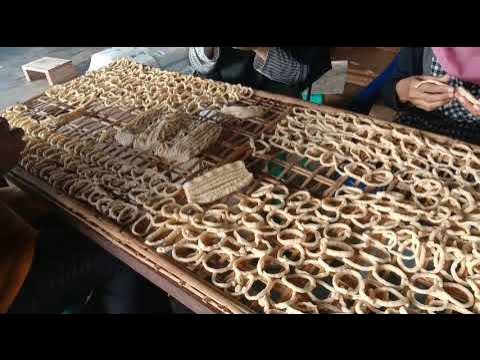90 Million Padlocks Annually! Unveiling the Mass Production Secrets in The Chinese Factory
Summary
TLDRThis video provides a comprehensive look at the step-by-step process involved in manufacturing padlocks. It covers various workshops where different components are produced, including copper rod cutting, lock body chamfering, trademark pressing, drilling, and lock cylinder milling. The script also explores key production stages like key slot washing, padlock pin manufacturing, and shackle cutting. Additionally, the video highlights the assembly of mechanical and electronic locks, including passive electronic locks, and testing procedures such as durability, salt spray, and reliability tests. Each stage emphasizes precision, efficiency, and the advanced machinery used to produce high-quality locks.
Takeaways
- 😀 Copper rods are cut according to a program in the cutting machine workshop.
- 😀 Lock bodies, typically cuboid or cylindrical in shape, undergo chamfering to smooth sharp edges for aesthetics and easier assembly.
- 😀 Trademarks are pressed onto the copper lock bodies using a flatbed press for branding.
- 😀 Automatic drilling machines are used in the combined drilling workshop to create precise holes in lock bodies for component installation.
- 😀 High-quality brass (copper-zinc alloy) is chosen for lock cylinders, with careful milling to ensure proper key insertion and smooth operation.
- 😀 The lock cylinder requires precise drilling for pin holes, ensuring accuracy in diameter, parallelism, and perpendicularity.
- 😀 Slotting machines are used to create grooves in the lock cylinder, allowing smooth key insertion and functioning of the internal lock mechanism.
- 😀 Key blanks are processed through slot milling, trademark pressing, and tooth profiling using specialized automatic machines.
- 😀 Padlock pins are made from copper alloys and are carefully cut, measured, and inspected for correct dimensions.
- 😀 The padlock shackle undergoes bending, milling, and stamping processes to achieve the required shape, cuts, and branding.
- 😀 Padlock assembly involves skillfully combining the lock body, lock cylinder, shackle, bolt, and key components, with rigorous quality inspection processes.
Q & A
What is the primary function of the cutting machine in the copper rod cutting workshop?
-The cutting machine cuts copper rods according to a programmed set of instructions, ensuring precision in size and shape for further processing.
How does the chamfering machine contribute to the lock body production process?
-The chamfering machine automatically smooths the sharp edges of the lock body, making it safer for assembly and improving its aesthetic appeal.
What is the role of the lock body trademark pressing workshop?
-The lock body trademark pressing workshop uses a flatbed press to imprint the trademark onto the copper lock body using mechanical pressure.
Why is the accuracy of drilling in the lock cylinder manufacturing workshop so important?
-The precision of drilling ensures the proper fitting of pins and other internal components, which allows for smooth operation and secure locking mechanisms.
What is the purpose of the slotting machine in the lock cylinder slotting workshop?
-The slotting machine creates grooves on the lock cylinder, which are crucial for allowing the key to fit and operate the internal pins and mechanisms.
What happens in the key slot washing workshop?
-In this workshop, key blanks are placed onto slot milling machines to cut out grooves of specific shapes, followed by pressing trademarks onto the keys using hydraulic presses.
How does the automatic key tooth profile machine improve key production?
-The automatic key tooth profile machine processes key blanks with preset programs to create precise tooth profiles, enhancing both the efficiency and accuracy of key production.
What is the purpose of the padlock pin manufacturing workshop?
-This workshop cuts and measures metal pin blanks to ensure they meet design specifications for length, diameter, and other key dimensions required for padlock functionality.
Why are the shackle bending and cutting machines important in padlock production?
-These machines ensure the padlock shackle is bent into the correct shape and size, with milling cuts made at specific points to form the necessary cuts for securing and locking the padlock.
How does the passive electronic lock differ from traditional mechanical locks?
-The passive electronic lock does not require an external power source for operation; instead, it receives energy and signals from external active devices like smart keys or dedicated readers, making it highly secure and easy to install.
Outlines

هذا القسم متوفر فقط للمشتركين. يرجى الترقية للوصول إلى هذه الميزة.
قم بالترقية الآنMindmap

هذا القسم متوفر فقط للمشتركين. يرجى الترقية للوصول إلى هذه الميزة.
قم بالترقية الآنKeywords

هذا القسم متوفر فقط للمشتركين. يرجى الترقية للوصول إلى هذه الميزة.
قم بالترقية الآنHighlights

هذا القسم متوفر فقط للمشتركين. يرجى الترقية للوصول إلى هذه الميزة.
قم بالترقية الآنTranscripts

هذا القسم متوفر فقط للمشتركين. يرجى الترقية للوصول إلى هذه الميزة.
قم بالترقية الآنتصفح المزيد من مقاطع الفيديو ذات الصلة

KEREN! BEGINI PERTANIAN KENTANG MODERN DI EROPA YANG CANGGIH

Memelihara Sistem Suspensi - Teknik dan Bisnis Sepeda Motor

How the ballpoint pen is made (the blue pen) #Boravê

Explain Dijkstra's Shortest Path Algorithm with Example in Hindi | Data Structure

The Manufacturing Process of Industrial Valves. 62 Years Old Cast Valve Factory in Korea

PEMBERDAYAAN UMKM // PROSES PRODUKSI
5.0 / 5 (0 votes)
